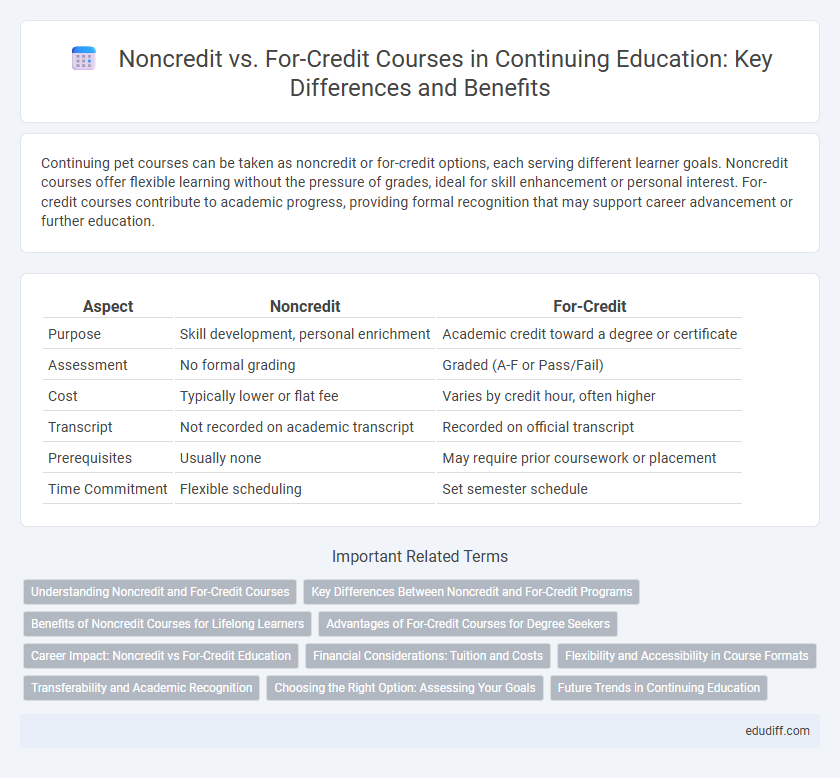Continuing pet courses can be taken as noncredit or for-credit options, each serving different learner goals. Noncredit courses offer flexible learning without the pressure of grades, ideal for skill enhancement or personal interest. For-credit courses contribute to academic progress, providing formal recognition that may support career advancement or further education.
Table of Comparison
| Aspect | Noncredit | For-Credit |
|---|---|---|
| Purpose | Skill development, personal enrichment | Academic credit toward a degree or certificate |
| Assessment | No formal grading | Graded (A-F or Pass/Fail) |
| Cost | Typically lower or flat fee | Varies by credit hour, often higher |
| Transcript | Not recorded on academic transcript | Recorded on official transcript |
| Prerequisites | Usually none | May require prior coursework or placement |
| Time Commitment | Flexible scheduling | Set semester schedule |
Understanding Noncredit and For-Credit Courses
Noncredit courses offer flexible learning opportunities without the pressure of earning academic credits, ideal for skill development or personal enrichment. For-credit courses contribute directly to a degree or certification, requiring assessments and adherence to academic standards. Understanding the difference helps learners choose the path that aligns with their educational and career goals.
Key Differences Between Noncredit and For-Credit Programs
Noncredit programs offer flexible learning opportunities without the pressure of grades or formal assessments, making them ideal for skill-building and personal enrichment. For-credit programs require meeting academic standards, contributing to a degree or certification with transferable credits that impact GPA. Unlike noncredit courses, for-credit classes typically have structured schedules, prerequisites, and tuition fees aligned with institutional policies.
Benefits of Noncredit Courses for Lifelong Learners
Noncredit courses offer lifelong learners flexible scheduling and affordable access to diverse subjects, enabling skill development without the pressure of grades or transcripts. These programs enhance personal growth and career advancement by providing practical knowledge tailored to individual interests and professional needs. Many institutions design noncredit courses to support continuous learning, making education accessible to all age groups and career stages.
Advantages of For-Credit Courses for Degree Seekers
For-credit courses offer degree seekers a clear advantage by providing transferable credits that count toward graduation requirements, accelerating the path to earning a degree. These courses often include structured curricula aligned with accreditation standards, ensuring recognized quality and rigor. Moreover, for-credit classes typically grant access to financial aid and academic advising, supporting students throughout their educational journey.
Career Impact: Noncredit vs For-Credit Education
Noncredit education offers flexible skill-building opportunities without the pressure of grades, ideal for professionals seeking immediate career enhancements or certifications. For-credit education provides formal recognition through transferable credits and degrees, making it essential for advancing within structured career paths or meeting credential requirements. Employers often value for-credit credentials higher, but noncredit courses can quickly adapt to industry trends, boosting practical expertise and job readiness.
Financial Considerations: Tuition and Costs
Noncredit courses typically have lower tuition fees compared to for-credit courses, making them more accessible for individuals seeking skill development without pursuing a degree. For-credit classes often require higher costs due to the inclusion of institutional fees, academic resources, and potential financial aid eligibility. Understanding these financial distinctions helps learners make informed decisions based on budget constraints and educational goals.
Flexibility and Accessibility in Course Formats
Noncredit courses offer greater flexibility in scheduling and pacing, allowing learners to engage at their own convenience without the pressure of exams or deadlines. For-credit courses typically follow a stricter timetable with set semesters and assessment requirements, limiting accessibility for those with variable schedules. Online and hybrid formats in both categories enhance accessibility, but noncredit options often provide more modular and self-paced learning paths suited for working professionals and lifelong learners.
Transferability and Academic Recognition
Noncredit courses typically do not offer academic credit transferable to degree programs, limiting their recognition by accredited institutions. For-credit courses provide official academic credits that are widely accepted by colleges and universities, facilitating transferability toward degree requirements. Students seeking formal academic advancement should prioritize for-credit options to ensure recognition and credit transfer.
Choosing the Right Option: Assessing Your Goals
Choosing between noncredit and for-credit courses depends on your educational and career goals; for-credit courses contribute to degree requirements and official transcripts, while noncredit courses often focus on skill development or personal enrichment without academic credit. If your aim is to advance professionally or fulfill prerequisites for advanced programs, for-credit options provide recognized credentials that enhance your academic record. Noncredit courses offer flexibility and targeted learning, ideal for acquiring new skills or exploring interests without the pressure of grades or GPA impact.
Future Trends in Continuing Education
Future trends in continuing education emphasize the growing integration of noncredit courses with personalized learning pathways, leveraging AI-driven platforms to enhance skill acquisition without formal credit constraints. For-credit programs are evolving to incorporate micro-credentials and stackable certificates, aligning more closely with workforce demands and enabling flexible career advancement. Hybrid models combining noncredit and for-credit elements are becoming prevalent, promoting lifelong learning and increasing accessibility for diverse learner populations.
Noncredit vs For-Credit Infographic

 edudiff.com
edudiff.com